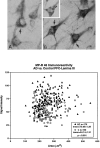Increased neuronal endocytosis and protease delivery to early endosomes in sporadic Alzheimer's disease: neuropathologic evidence for a mechanism of increased beta-amyloidogenesis
- PMID: 9236226
- PMCID: PMC6568334
- DOI: 10.1523/JNEUROSCI.17-16-06142.1997
Increased neuronal endocytosis and protease delivery to early endosomes in sporadic Alzheimer's disease: neuropathologic evidence for a mechanism of increased beta-amyloidogenesis
Abstract
The early endosome is the first vacuolar compartment along the endocytic pathway. It is the site of internalization and initial processing of amyloid precursor protein (APP) and apolipoprotein E (ApoE), two proteins of etiological importance in Alzheimer's disease, and a putative site of beta-amyloid peptide (Abeta) formation. Here, we identify early endosomes in human pyramidal neurons, using specific compartmental markers and morphometry, and show that in Alzheimer's disease individual endosomes display up to 32-fold larger volumes than the normal average. Endosomal enlargement contributed to an average 2.5-fold larger total endosomal volume per neuron, implying a marked increase in endocytic activity. Endosomal alterations were evident in most pyramidal neurons in Alzheimer brain, detectable at early stages of the disease but absent in several other neurodegenerative disorders examined. In addition, mature and proenzyme forms of the proteases cathepsin B and cathepsin D, a candidate APP secretase, were identified in most early endosomes in Alzheimer brains but were detectable in only a minor proportion of endosomes in normal brain. Expression of the cation-dependent 46 kDa mannose 6-phosphate receptor was elevated in pyramidal neurons of Alzheimer brains, which could be a possible basis for the altered cathepsin trafficking pattern. Enhanced endocytic activity, coupled with increased trafficking to endosomes of proteases, which may have the ability under pathological conditions to generate Abeta, constitutes a potential mechanism by which beta-amyloidogenesis may become accelerated in sporadic AD and also be subject to influences by ApoE.
Figures





References
-
- Araki W, Kunishita T, Takahashi K, Ikeda S, Tabina T. Demonstration of amyloid β-protein secretion in a mouse neuronal cell line. Neurosci Lett. 1994;167:125–127. - PubMed
-
- Bernstein HG, Wiedanders B. An immunohistochemical study of cathepsin E in Alzheimer-type dementia brains. Brain Res. 1994;667:287–290. - PubMed
-
- Bleekemolen JE, Stein M, von Figura K, Slot JW, Geuze HJ. The two mannose 6-phosphate receptors have almost identical subcellular distributions in U937 monocytes. Eur J Cell Biol. 1988;47:366–372. - PubMed
Publication types
MeSH terms
Substances
Grants and funding
LinkOut - more resources
Full Text Sources
Other Literature Sources
Medical
Miscellaneous
